
GUEST BLOGGER VICKY FANG
Expressing ideas: thinking, making, writing
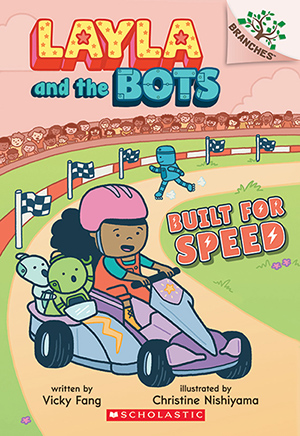

Hi! I’m Vicky Fang. I spent years at Google and Intel inventing products for kids. Much like Layla, I worked with a talented team to create all sorts of fun products—like robots you could build at home, buildings that played music, or games you could play with your voice. And just like Layla, I used a design process that students can use too! Part of inventing is being able to express your thoughts and ideas. That’s just what this lesson is designed to help students do. I’ve outlined an invention project for your classroom below, whether in person or virtual, that promotes creative thinking, problem solving, making, and writing.
Getting started
There are four steps to expressing ideas: Investigate, Ideate, Implement, and Improve. To get started, click the Invention I’s image below to download the following three handouts:
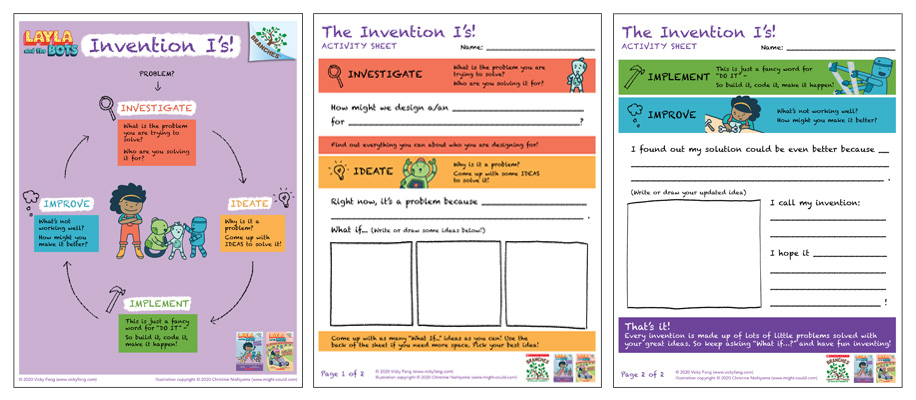
handouts.Expressing ideas: Design Thinking Primer
Materials:
- Layla and the Bots book (Happy Paws and/or Built for Speed)
- Layla and the Bots Invention I’s handouts above
Have students read a Layla and the Bots book. (This can be done aloud as a group or individually, broken into multiple sessions as needed.)
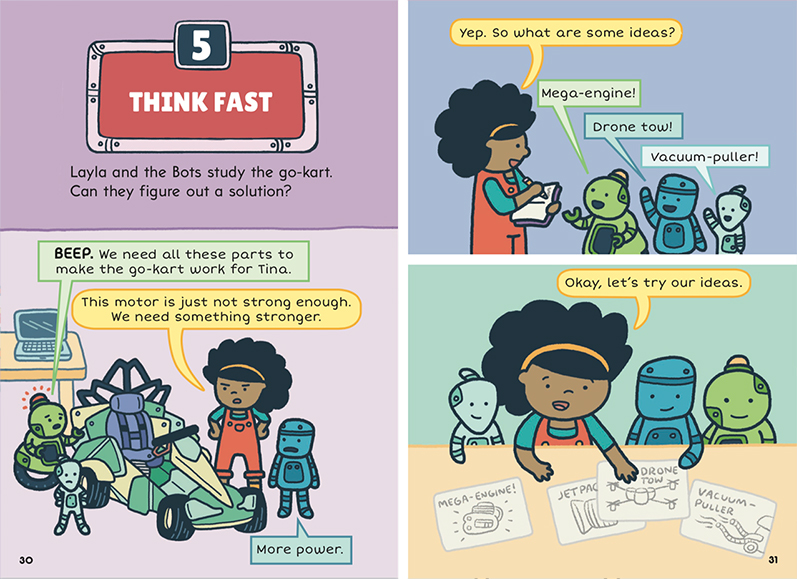
Use the “Invention I’s” cover diagram (downloaded above) to help discuss the following questions as a group:
- What problem were Layla and the Bots trying to solve? Who were they trying to solve it for?
- How did they investigate the problem? How did they learn about the audience they were designing for?
- What idea did they come up with to solve their problem?
- How did they implement their idea? What did they build and how?
- How did they iterate on their invention? What did they have to change and why?
For Layla and the Bots: Built for Speed, Book 2, the answers might look something like this:
- “How might we design a go-kart for Tina, a girl who uses a wheelchair?”
- “Right now, it’s a problem because it’s hard for her to get in/out of the go-kart and the gas/brake are controlled by foot pedals. What if we added a power seat and hand controls?”
- “I found out that my solution isn’t great yet because the new equipment is too heavy for the go-kart motor.
- What if we added a jet-pack for extra power?”
You’ll see that Layla and the Bots solve more than one problem in their invention process—because invention is all about learning and solving lots of problems along the way!
Design Challenge: Invent a Musical Instrument
The Invention I’s activity sheets are designed to help students express their design and thought process as they invent. You can use these worksheets with any sort of design challenge, but I’ve put together a lesson plan for a musical instrument challenge here.
To get your students excited for their musical instrument challenge, set-up the followig premise: Bop forgot his guitar! He needs a new musical instrument, and fast. He’s excited to try anything, but it must make at least four different sounds!
Materials:
- Recycled/found materials such as cardboard, straws, sticks, bottles, paper, fabric, balloons, rubber bands, plastic bags, egg cartons, beads, etc.
- Crafting materials such as tape, glue, scissors
- Layla and the Bots “Invention I’s” Activity Packet (printed for each student/group)
Estimated Time:
- Approximately 1.5 hours for an in-person challenge, or
- 3-5 days for a virtual challenge (w/ a 45-minute kickoff and a 45-minute final celebration)
Expressing ideas with the 4 I’s

Talk together as a group to articulate the problem they are being asked to solve. Have your students fill out the “Investigate” section of the activity sheets based on the discussion.
- What is the problem you are trying to solve?
- Who are you solving it for?
For example:
“How might we design a musical instrument for Bop?”
Encourage the students to learn as much about the problem and who they are designing for as possible.
Look at examples of musical instruments and how they work/sound. What kinds of musical instruments exist? How do they make sound? How do they change pitch? Here’s a helpful resource with a simple explanation, visuals, and audio. Think about other instruments and how they create sound through vibration – hitting, plucking, shaking, etc.
What kind of musical instrument do you think Bop would like? Loud or soft? High pitch or low pitch?

As a group, define the problem, and then invite the students (individually or in small groups, as appropriate) to spend a few minutes generating ideas, writing them down or drawing pictures in the “Ideate section” of their activity sheets.
- Why is it a problem?
- Come up with ideas to solve it!
For example:
- “Right now, it’s a problem because we need these materials to make sounds!
- Should we make a drum out of cardboard?
- What if we made strings out of rubber bands?
- What if we made a maraca out of beads and a cardboard tube?”

Invite your students to start building! Check in with each group to see how their process is going.

Test and see how the instruments are working!
Students have probably been testing and improving as they build, but ask students to take a moment to test their instruments as a whole. What do they think could be improved on their design? Does it make 4 different sounds? Could they make it louder or cooler or easier to play, etc? Have them fill out the “Improve” section of the activity sheets with their thoughts and ideas.
- What’s not working well?
- How might you improve it?
Some possible answers include:
- “I found out that my solution isn’t great yet because the rubber bands won’t stay in place. What if we wrap the rubber bands around the instrument?”
- “I found out that my solution isn’t great yet because it looks kind of boring.
- What if we added decorations?”
Give students time to improve their instrument. It may be that students jump to re-building before filling out the activity sheet, which is totally fine! It’s designed to work either way.
Expressing ideas through music – the demonstration
Give each group 2-3 minutes to present the title of their instrument and how they improved it before a final performance! Cheer each other on!
TIP: If needed, presentations can be done on another day, or even via individually shared videos for virtual classrooms. Just jump to the conclusion and invite students to continue improving their instruments for their final presentation!
Celebrate the wonderful musical inventions of the day and remind students that they can always continue to improve their instrument inventions by repeating the cycle of investigate, ideate, and implement! Every invention is made up of lots of little problems solved with somebody’s great ideas. So encourage them to keep asking “What if…?” and have fun inventing!

For more activities from Vicky Fang, visit her website: www.vickyfang.com/activities
Vicky Fang is a product designer who spent 5 years designing kids’ technology experiences for both Google and Intel, often to inspire and empower kids in coding and technology. She started writing to support the growing need for early coding education, particularly for girls and kids of color. Her goal is for her books to inspire computer literacy for a wide range of kids—while letting their imaginations run wild with the possibilities of technology! She is the author of the LAYLA AND THE BOTS early chapter book series, as well as the INVENT-A-PET picture book and the I CAN CODE board book series. Find out more about Vicky by following her on Twitter at @fangmous or on her website at www.vickyfang.com.
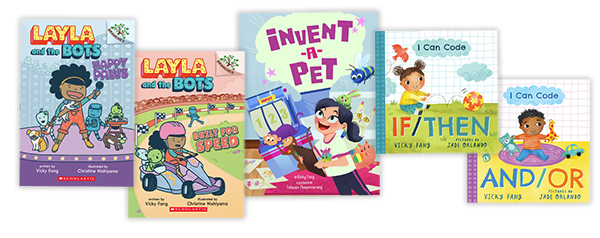




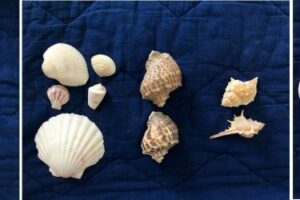
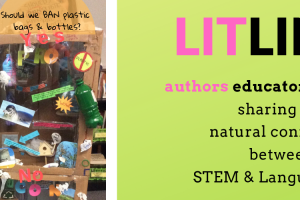


Leave a Reply
Your email is safe with me.